
Lesson 1/Learning Event 2
Learning Event 2
GRADATION QUALITY
To standardize the gradation criteria, two coefficients were developed based on the Grain Size
Distribution Curve: the Coefficient of Uniformity (Cu) and the Coefficient of Curvature (Cc). These
coefficients are defined as follows:
The grain size which corresponds to 10 percent passing on the grain size distribution curve is called
Hazen's effective size; it is designated by the symbol D10. The uniformity coefficient (Cu) is the ratio
between the grain diameter corresponding to 60 percent passing on the curve (that is D60) and the 10
percent passing (D10). Hence, Cu = D60/D10.
The coefficient of curvature, designated by the symbol Cc, is written
Cc = (D30)2/D60 X (D10)
D10 and D60 have meanings previously assigned, while D30 is the grain diameter corresponding to 30
percent passing on the grain size distribution curve.
As we learned earlier, a soil having a good representation of all particle sizes from the largest to the
smallest is defined as a well-graded soil. In the Unified Soil Classification System, well-graded gravels
must have a Cu value greater than 4, and well-graded sands must have a Cu value greater than 6. Both
sands and gravels must have a value for the coefficient of curvature between 1 and 3 to be well graded.
Those not meeting these conditions are termed poorly-graded soils.
Therefore, in order for a soil to be considered well-graded, it must meet the following criteria:
1. Its grain size distribution must plot a smooth curve. (The curve must not have any horizontal or
vertical portions and must be continuous.)
12



 Previous Page
Previous Page
